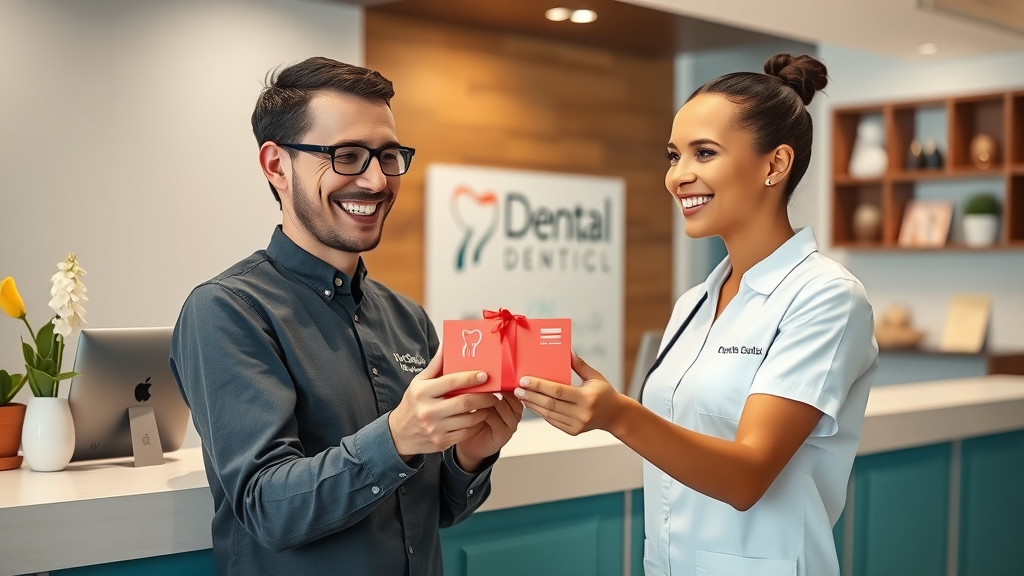Did you know up to 70% of inactive dental patients can be reactivated with the right campaign? Most dental practices lose thousands of dollars every year due to missed opportunities with inactive patients and weak or absent reactivation programs. If you’re determined to turn dormant records into thriving, loyal patients, this comprehensive guide to Dental Patient Reactivation reveals practical, proven strategies to help you reclaim patients, grow practice revenue, and build relationships—fast.
Unlocking Dental Patient Reactivation: Surprising Facts That Will Change Your Strategy

- Up to 70% of inactive dental patients can be reactivated with strategic outreach.
- Most dental practices miss out on thousands in annual revenue by neglecting patient reactivation campaigns.
- Effective reactivation programs can return 3–5x ROI compared to new patient acquisition efforts.
Understanding the impact of patient reactivation can be a game-changer. For instance, an office manager who reviews inactive patient lists may discover a group of patients who simply forgot to reschedule. By sending a friendly reminder or a phone call, these patients are often eager to return for dental care, oral health checkups, and even outstanding treatment plans. These small actions accumulate and significantly increase active patient counts, giving your dental practice a measurable revenue boost without the steep costs of attracting a brand-new client.
With the dental market growing increasingly competitive, the practice management advantage lies in tapping into your existing pool of inactive patients. Data from the American Dental Association suggests reactivation campaigns are one of the most cost-effective ways to keep your dental chairs full and your team members engaged. Let’s explore why reactivation matters, who qualifies as an “inactive patient,” and what strategies really work.
Why Dental Patient Reactivation Matters: The Foundation of Dental Practice Growth
The Role of an Active Patient Base in Dental Practices
- Understanding the importance of active patients and their impact on practice revenue and reputation.
An active patient base is the heartbeat of any successful dental practice. Active patients schedule and keep their regular appointments, accept recommended treatment plans, and often refer friends and family. Maintaining a robust roster of active patients is directly tied to your practice’s financial health, reputation, and ability to provide quality oral health care to the community. In fact, high patient engagement and consistent recall visits reduce patient acquisition costs and stabilize your office’s cash flow, transforming the day-to-day operations of your team members—especially when compared to the time and effort spent chasing new patients.
Not only do active patients generate continuous revenue, but they also help reinforce your dental practice's reputation. Satisfied patients leave positive reviews and contribute to word-of-mouth growth, setting your practice apart from others in the increasingly crowded dental market. Building long-term relationships with these patients lays the foundation for sustainable growth and a legacy of exceptional dental care.
Inactive Patients: Hidden Value in Your Dental Practice
- Examining trends in inactive patients within dental practices and how targeted reactivation campaigns tap into untapped revenue streams.
Every dental practice has a silent, yet significant, asset: inactive patients . These are individuals who once trusted you with their oral health but, for a variety of reasons, have not scheduled or attended an appointment within the past 12 to 24 months. According to industry research, even a 10% increase in reactivated patients can lead to substantial revenue growth. The reality is, inactive patients have already experienced your services, making them more likely—and less costly—to win back compared to net new patients.
A well-designed reactivation campaign can uncover this hidden value . By using targeted communication, reminders about outstanding treatment, and incentives like a gift card or special dental care offers, dental professionals can tap into an existing database and fill open appointment slots. This proactive approach not only supports financial performance but also fulfills your commitment to ongoing oral health and patient engagement, keeping the community healthier overall.
What You'll Learn About Dental Patient Reactivation
- Proven strategies for launching a successful reactivation campaign
- Tips for designing an effective reactivation program in your dental practice
- Common pitfalls to avoid with inactive patients
- Real-world examples from high-performing dental practices
- Answers to top questions about patient reactivation in dentistry
Defining Dental Patient Reactivation and the Benefits for Your Dental Practice
What Is a Dental Patient Reactivation Program?
- A comprehensive overview of structured reactivation programs, actionable steps, and why they're essential for growth.

A Dental Patient Reactivation Program is a systematic, repeatable process designed to reconnect and re-engage inactive patients . It typically involves a blend of outreach channels—like phone calls, personalized emails, SMS reminders, and even direct mail—and includes a tracking system via your practice management software. The goal is to remind patients about necessary dental care, such as overdue cleanings or outstanding treatment plans, and encourage them to return.
To be effective, a reactivation program must be actionable. That means maintaining clean, segmented patient lists, using automation where possible for reminders, and tracking each step of the outreach. An organized, motivated dental professional or office manager anchors the program—ensuring consistent follow-through and responsiveness to patient needs, fueling the overall success of your dental practice.
Advantages of Patient Reactivation Campaigns
- Increased appointment rates, reduced patient acquisition costs, and stronger patient relationships.
Launching a focused reactivation campaign can transform dental practices by increasing appointment rates and reducing the cost of acquiring new patients. Since inactive patients are already familiar with your practice, encouraging them to return is much more efficient (and cost-effective) than marketing to total strangers. This means practices see a direct bump in revenue without heavy external advertising investment.
Additionally, reactivation efforts often lead to stronger patient relationships and improved patient engagement. By reaching out thoughtfully—sometimes with a small gift card , incentive, or friendly note—patients feel valued and cared for, not just contacted for business. This boosts loyalty and trust, supporting long-term practice growth and enhanced oral health outcomes for your entire community.
Identifying Inactive Patients: Who Needs Dental Patient Reactivation?
Defining Inactive and Recall Patients in Dentistry
- Distinguishing between inactive patients, recall patients, and their importance in practice management.
Within a robust practice management system , patients are separated into specific segments. Inactive patients are those who haven’t visited for a set time period (often 12–24 months), while recall patients are due, or past due, for routine dental care (such as cleanings or checkups). Both groups represent opportunities for reactivation, but each requires slightly different outreach messages and timing.
It’s essential for dental professionals to clearly define these patient types in their management system and to develop tailored reactivation campaigns that suit each group. Recall patients may respond best to gentle reminders or an appointment link, while truly inactive patients often require personal outreach or added incentives, like teeth whitening or a gift card for returning.
Segmenting Patient Lists for Effective Reactivation Campaigns
- How to use dental practice management tools to categorize active and inactive patients for targeted communication.
The cornerstone of a winning reactivation strategy is effective patient segmentation. Using your dental practice management system , categorize patients based on last appointment date, treatment history, and recall needs. This enables you to create personalized messages for each group—making your campaign far more effective than a generic email blast.
Segmented lists empower your team members to prioritize outreach, automate reminders, and track responses. By focusing efforts where the greatest potential lies, dental practices maximize both staff productivity and reactivation results, ensuring more patients back in your chairs and a healthier bottom line.
Building a Dental Patient Reactivation Strategy That Works
Step-by-Step: Crafting a Custom Reactivation Program
- Outline decisive actions for building reactivation strategies that address your dental practice’s unique challenges.
To launch an effective reactivation program , follow an actionable plan:
- Audit your current patient database to identify inactive and recall patients.
- Segment these lists based on patient history, last visit, and outstanding dental treatment.
- Develop targeted communications using phone calls, emails, SMS, and direct mail.
- Incorporate powerful incentives (such as a gift card or free oral health checkup) where appropriate.
- Assign accountability to a dedicated dental professional or office manager.
- Utilize practice management software to automate reminders and track outcomes.
This approach ensures your team isn’t overwhelmed and that every inactive patient receives a personalized, well-timed message designed to get them re-engaged and booked.
Launching a Successful Reactivation Campaign: Best Practices
- Case studies from leading dental practices show how tactical outreach and digital tools can restore active patient relationships.

High-performing dental practices rely on tactical, multi-channel reactivation campaigns . Start by assigning team members to specific segments: some focus on personal phone calls to a select group of patients, while others trigger automated email and SMS reminders to broader lists. Incorporate technology like CRM or dental practice management tools to keep the process seamless and measurable.
One proven best practice is layering outreach: send an initial email with a gentle reminder, follow up with a scheduled phone call (using a patient-friendly script), and reinforce with a direct mail postcard featuring an incentive—such as a free dental care consultation or a gift card after their first visit back. Regular team huddles and performance tracking keep your reactivation strategy sharp and agile.
Key Channels for Dental Patient Reactivation: Phone Calls, Email, Text, and Direct Mail
The Power of Phone Calls in Patient Reactivation
- Scripts and call flows proven to convert inactive patients into active return visits.
Among all channels, phone calls stand out for their personal touch and high response rate. A direct, empathetic phone call from a trusted team member reminds patients of their value to your practice. Preparing a reactivation call script—starting with a friendly greeting, referencing the patient's last visit, and offering help to schedule—can convert even the most hesitant inactive patient.
Successful calls are concise, respectful, and focused on patient needs. They provide clear next steps and, where allowed by regulations, may include a special offer or gift card incentive. Always confirm contact details and update records for every conversation, ensuring future reactivation efforts are built on accurate information, like email addresses and phone numbers.
Digital Channels: Leveraging Email and SMS for Reactivation Campaigns
- Automation, personalization, and timing—how leading dental practices use digital outreach for maximum response.
In today’s fast-paced world, email and SMS are the backbone of modern reactivation campaigns . Automating emails with practice management software saves time and ensures every inactive patient receives a personalized reminder—often with appointment links or oral health tips. SMS complements email by reaching busy patients instantly, and can serve as a last-minute nudge the day before or day of scheduled care.
Best practices include crafting subject lines that emphasize patient benefits (e.g., “Let’s get your smile back!”), segmenting lists for tailored content, and tracking open/click rates to measure campaign effectiveness. Mixing digital with analog approaches drives even higher reactivation program ROI.
Direct Mail & Physical Reminders in Patient Reactivation
- Creative direct mail campaigns with high recall rates and ROI for dental patient reactivation.

Despite the digital age, direct mail remains a valuable channel for reactivation campaigns . Creative, colorful postcards and handwritten notes cut through digital noise—especially for senior patients or those less tech-savvy. Including appointment times, contact numbers, or a gift card for returning can trigger impressive response rates, often exceeding 25% for well-executed campaigns.
Consider timing direct mail sends around seasonal health reminders, and pair physical notes with follow-up digital messages to reinforce your call to action. This omnichannel strategy ensures you capture every patient preference and maximize reactivations throughout your dental practice.
Incentives for Dental Patient Reactivation: Do Gift Cards and Offers Work?
Gift Cards as Patient Reactivation Tools
- Examples of successful gift card incentives, how to structure the offer, and compliance considerations.

Offering a gift card has proven to be a powerful motivator for dental patient reactivation. Dental practices may provide a small-value card redeemable at a popular retailer or in the form of account credit applied after a returned appointment. To ensure compliance, clearly communicate terms, avoid offering incentives for specific treatments, and check with local regulations regarding patient incentives. Many leading dental practices have seen response rates increase by 40–60% with gift card campaigns, especially among value-oriented and “on the fence” patients.
Gift card offers can be delivered via email, direct mail, or in person following a successful visit. Make them time-limited to instill urgency and track redemptions in your management system for accurate campaign ROI calculation.
Other Incentives: Free Whitening, Discounted Cleanings, and More
- Alternatives to gift cards that drive patient reactivation and boost oral health outcomes.
Beyond gift cards, successful dental patient reactivation campaigns often use offers like free teeth whitening, discounted cleanings, or oral health kits to attract inactive patients back into care. These incentives not only encourage appointments but also support the mission of preventive dentistry and overall well-being for your group of patients.
Design incentives that align with your office’s treatment goals, such as promoting regular checkups or addressing outstanding treatment. Be transparent about eligibility and ensure that offers are accessible but not overly costly to the practice. When balanced well, these motivators boost both reactivation rates and the reputation of your dental practice as a patient-centered provider.
Practice Management and Dental Patient Reactivation: Technology and Tracking
CRM and Dental Practice Management Software for Reactivation
- How to set up automated tracking, reminders, and results measurement for reactivation programs within dental practice management systems.
Modern practice management and CRM software have transformed how dental offices handle patient reactivation . With automated reminders, customizable workflows, and real-time reporting, these tools streamline every step of a reactivation program . Start by capturing accurate data on every patient, then customize reminder sequences based on last visit, outstanding treatment, or preferred communication channel.
Assign specific team members (such as the office manager or front desk staff) to oversee the program, ensuring accountability and quick adaptation if initial reactivation efforts stall. Regularly audit your program’s performance and leverage your software’s dashboard to visualize trends in appointment scheduling and campaign ROI.
Measuring Reactivation Campaign ROI
- Key metrics, success rates, and how to interpret your program's impact on active patients and revenue.
Measuring the success of your dental patient reactivation program means tracking key metrics like:
- Reactivation rate: The percentage of contacted inactive patients who return.
- Revenue generated from reactivated patients.
- Average cost per reactivated patient vs. new patient acquisition cost.
- Patient engagement metrics (open rates, response rates, and appointment attendance).
Clear, real-time reporting built into your practice management system makes it easy to analyze campaign ROI. Using these insights, dental practices can fine-tune outreach, invest in the most effective channels, and report measurable improvements in both patient numbers and profit margins.
| Method | Cost | Avg. Response Rate | Best For | Example |
|---|---|---|---|---|
| Phone Calls | $$ | 50% | Lapsed patients | Welcome-back call |
| $ | 30% | Younger adults | Personalized recall note | |
| SMS | $ | 40% | Busy professionals | Quick appointment reminder |
| Gift Card Offers | $$ | 60% | Value-focused | $25 gift card after visit |
| Direct Mail | $$ | 25% | Seniors | Postcard check-in |
Common Challenges in Dental Patient Reactivation—and How to Overcome Them
Addressing Patient Concerns: Trust and Engagement
- Building genuine relationships and reestablishing trust with inactive patients.
Many inactive patients hesitate to return due to anxiety, busy schedules, or financial concerns. Your reactivation calls and communications need to address these barriers proactively by prioritizing empathy, flexibility, and transparency. Reassure patients that their oral health is your top priority, and offer supportive resources or payment options if necessary. Restoring trust and demonstrating continued commitment to high-quality dental care transforms reactivation interactions into long-term loyalty and strong patient engagement.
Overcoming Team Resistance to Reactivation Programs
- Staff training tips for successful reactivation program implementation in dental practices.
Dental teams may resist reactivation efforts if the program seems too complex or burdensome. Overcome this by breaking down reactivation tasks into manageable steps, providing clear training, and celebrating early wins (like a patient returning after a personalized outreach). Encourage every team member to see reactivation as a chance to connect and make a difference, rather than a simple administrative task. Leadership buy-in and ongoing support keep the program sustainable—and your practice thriving.
"Every reactivated dental patient is proof that proactive care builds lifelong relationships and a profitable practice." – Leading Dental Consultant
Real Examples: Successful Dental Patient Reactivation Campaigns
- Case Study 1: A suburban dental practice reactivated 120 patients in 30 days by combining friendly phone calls with targeted email follow-ups, offering convenient scheduling for overdue cleanings.
- Case Study 2: Using gift cards as thank-you incentives, a practice boosted recall visits by 40%, particularly among value-focused families and young professionals.
- Case Study 3: By blending phone, email, and SMS, another dental practice achieved a remarkable 75% reactivation campaign success rate—showing that versatility in outreach pays dividends in all patient segments.
Patient Abandonment and Ethical Considerations for Dental Practices
- Clarifying what constitutes patient abandonment, how to prevent it when performing reactivation campaigns, legal and ethical protocols to follow.

Patient abandonment occurs when a dental practice severs care without proper notice or handoff, risking patient health and legal consequences. Ethical dental patient reactivation requires clear, consistent communication—if patients do not respond after multiple outreach attempts, document every contact and offer transfer options or next steps in writing. Always secure and respect patient privacy, follow industry and state-specific protocols, and ensure every outreach upholds the highest standards of care.
People Also Ask: Dental Patient Reactivation Questions
How to reactivate dental patients?
- Reactivate dental patients by segmenting inactive lists, creating targeted reactivation campaigns using emails, calls, or gift cards, and using automation to streamline outreach. Follow up with personal reminders to maximize engagement.
What is a recall patient in dentistry?
- A recall patient is someone due or overdue for their routine dental care appointment. Reactivation programs target recall patients who haven’t scheduled in a while, using reminders or incentives to encourage return visits.
What constitutes patient abandonment in dentistry?
- Patient abandonment occurs when a dental practice abruptly stops care without proper notice, transfer, or follow-up. Ethical dental patient reactivation ensures continuation of care and proper communication.
Can my new dentist access my dental records?
- Yes, with your consent, your new dentist can request and access dental records from previous dental practices to provide continuity of care.
Expert Tips for Sustained Dental Patient Reactivation and Practice Success
- Regularly review your inactive patient list.
- Test and measure different reactivation strategies—including gift cards .
- Train your team for effective patient engagement and communication.
- Combine automation with personalized outreach for higher ROI.
- Celebrate every win—every reactivated patient is a testament to your team’s dedication!
Frequently Asked Questions About Dental Patient Reactivation
- How often should we run reactivation campaigns in our dental practice? Conduct reactivation campaigns at least quarterly, or monthly for high-volume offices.
- Which incentives offer the best ROI for dental patient reactivation? Gift cards and discounted cleanings consistently deliver the highest response rates, especially when combined with multi-channel outreach.
- What’s the difference between recall and inactive patients? Recall patients are due for routine care; inactive patients have lapsed significantly beyond their last scheduled visit.
- How long should a reactivation program last for optimal results? Programs should run for at least 90 days with regular follow-up and ongoing measurement for continuous improvement.
Maximize Returns: Why Dental Patient Reactivation is Essential for Every Dental Practice
- Dental patient reactivation programs are cornerstone strategies for growth in dental practices, helping recover lost revenue, strengthen patient loyalty, and establish sustainable practice management.
Take the Next Step: Start Your Dental Patient Reactivation Program Today
- Act now: Audit your inactive patient list and implement a reactivation campaign within your dental practice this quarter for measurable improvements in active patient engagement and profitability.
Ready to boost patient engagement and practice profits? Take decisive action now—launch your reactivation program and watch your dental practice thrive!
Reactivating inactive dental patients is a strategic approach to boost your practice’s growth and revenue. Implementing a comprehensive reactivation program can help you reconnect with patients who haven’t visited in a while, encouraging them to return for their dental care needs.
Developing a Reactivation Plan
Start by identifying inactive patients—those who haven’t had an appointment in the past 18 to 36 months. Segment this list based on factors such as the length of inactivity and reasons for their absence. This segmentation allows for targeted outreach, making your reactivation efforts more effective. ( dentalcare.com )
Personalized Outreach
Engage inactive patients through personalized communication channels like phone calls, emails, and text messages. Address patients by name and reference their previous visits to create a sense of familiarity and value. For instance, a friendly phone call can effectively remind patients of their overdue appointments and the importance of maintaining their oral health. ( dentistryiq.com )
Offering Incentives
Incentives can be a powerful motivator for patients to return. Consider offering discounts, complimentary services, or special promotions tailored to the patient’s needs. For example, providing a free hygiene visit or a discounted cleaning can entice patients back to your practice. ( dentistryiq.com )
Utilizing Digital Tools
Leverage digital tools like automated reminders and email marketing to streamline your reactivation efforts. Automated appointment reminders can enhance engagement without increasing your practice’s administrative workload. Additionally, crafting compelling email campaigns with clear calls-to-action can effectively encourage patients to schedule their next visit. ( demandhub.co )
Measuring Success
Track the effectiveness of your reactivation campaigns by monitoring key metrics such as reactivation rates, revenue generated from reactivated patients, and patient engagement levels. This data will help you refine your strategies and ensure continuous improvement in patient retention. ( painfreedentalmarketing.com )
By implementing these strategies, you can successfully reactivate inactive patients, enhance patient relationships, and drive the growth of your dental practice.
 Add Row
Add Row  Add
Add 




Write A Comment